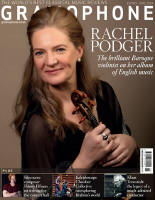Texte paru dans: / Appeared in:
|
|
|
|
|
|
This is a debut release for harpsichordist Melody Lin, showcasing her impressive finger dexterity in a selection of the instrument’s virtuoso warhorses. Lin trained as a pianist in her native Taiwan before switching to the harpsichord during postgraduate studies in the US, and fearlessness in the face of demanding pages of notes is strongly pushed as her métier here, whether those notes be thickly packed together in Farnaby and Byrd or athletically strung out in Bach and Rameau.
It is good to see two English virginalists on the programme; Giles Farnaby’s slightly crazed Wooddy-Cock challenges both hands equally, and Byrd’s Fantasia, brilliant as ever, builds up a head of steam in what the booklet describes as ‘wilfully anachronistic’ cross-rhythms. Lin covers these courses with satisfying control and clarity but could have taken more care to make Farnaby’s theme sing in its earlier, plainer statements. Bach’s D major Toccata is a piece with a wider range of expression, and if Lin does not quite catch the rhetorical swagger of the opening or let the freer adagio section breathe as it might, the gathering swirl of the final gigue captures the exciting sense of almost alarming exuberance on the young composer’s part. Rameau’s visionary Les Cyclopes proves no great challenge to her technical skills, but while she finds more space in it for give and take, it is not always coherent, and the strength with which she rattles off the thick-set but texturally detailed Forqueray pieces could have been tempered by a more varied approach to the speed of spread chords and more lightness where the music offers the chance.
So yes, Lin is a player with the chops to make these showpieces work a bit of virtuoso magic but it would have been interesting to hear a more delicate and ruminative side to her, too – perhaps that’s what she will give us next time. The harpsichord is a copy of a 1730 Blanchet which a marginally less close recording might have made easier on the ear over time. The decision by the editor to fade swiftly to black not only on final chords (presumably to lose the sound of the keys coming up?) but also between sections of a piece is – well, let’s just say it’s not a good one. |
|




